The first forms of life on our planet appeared 540 million years ago.
Seashells are one of the oldest forms of animal life.
Below is the chronology of the main forms of life with the 12 geological eras
(Cambrian, Ordovician, Silurian, Devonian, Carboniferous, Permian, Triassic, Jurassic, Cretaceous, Paleogene, Neogene, Holocene**).
(**)The Holocene era began in 9700 BC.
The Anthropocene period (or Human era) began in 1610 (when the Old World met the New World).
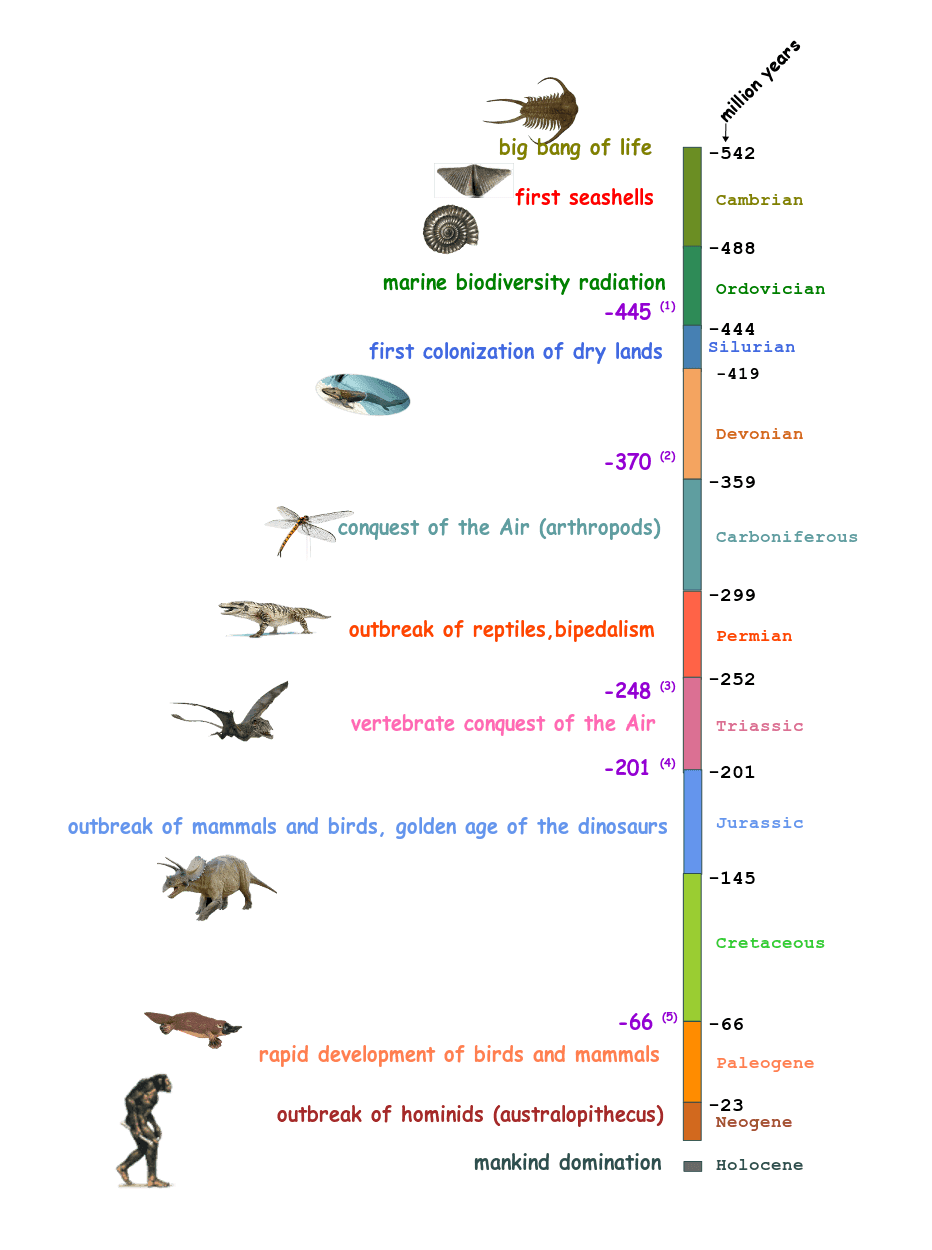
There were 5 massive extinctions of species in -445, -370, -248, -201 and -66 million years ago.
The impact of human activity on the climate, ecosystems and the overexploitation of natural resources has triggered what scientists suspect as the sixth mass extinction of our planet. ☹

In the animal kingdom, seashells are mainly found in 3 classes of the phylum molluscs (which includes 8 in total)
The animal kingdom is one of the 7 kingdoms of the living world
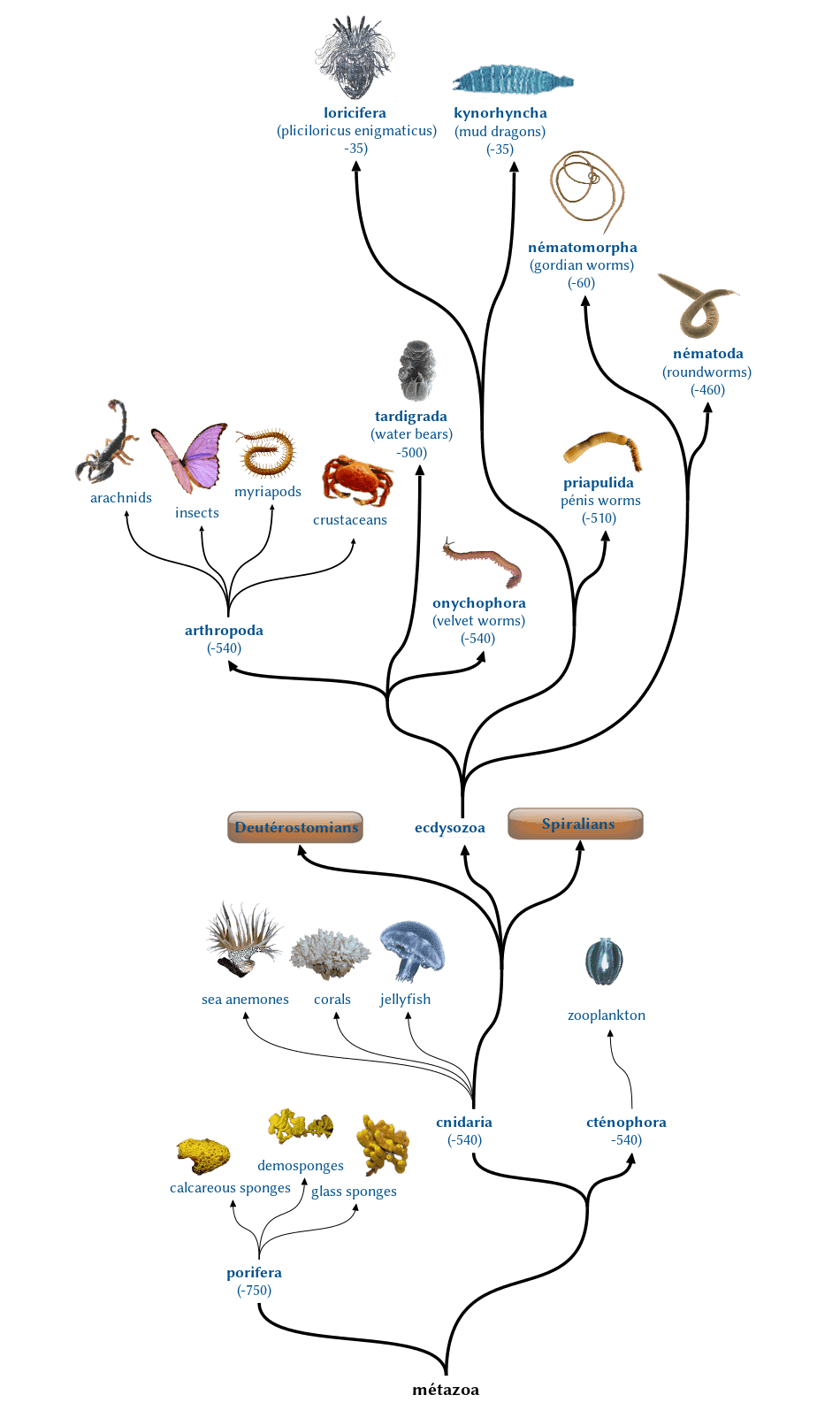


click a button inside the picture (Deuterostomians, Ecdysozoans or Spiralians) to switch between branches.
An old classification of the animal kingdom distinguishes:
Acanthocephalans

Annelids

Arthropods

Brachiopods

Bryoza

Chaetognaths

Chordates

Cnidarians

Ctenophores

Cycliophorans

Dyciemida

Echinoderms

Entoproctans

Gastrotrichs

Gnathifera

Gnathostomulidans

Hemichordates

Kinorhynchans

Loriciferans

Molluscs
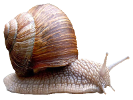
Nematodes

Nematomorphs

Nemertians

Onychophorans

Orthonectidans

Phoronids

Placozoans

Platyhelminthes

Poriferans

Priapulids

Rotifers

Tardigrades

Xenacoelomorpha

When we speak of seashells we generally think of the shell, forgetting that it is first of all a living animal (a mollusk master of adaptation) which inhabited this shell.
Molluscs have 5 synapomorphies that characterize this branch (or phylum) of the animal world (the metazoans) :
The mantle forms a sort of cape draping the shell of the animal. It has the crucial task of containing visceral mass. For conchifers, the mantle has another function: to build and maintain the shell.
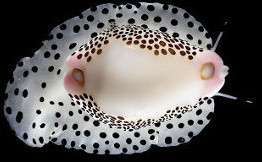
Calpurnus verrocus mantle
The pallial cavity is a space formed by the folds of the mantle. For most molluscs it contains the gills and acts as a respiratory chamber. In bivalves it is used to suck food. In cephalopods and scallops it is also a locomotion organ.
Mollusc siphons are tube-like structures in which water circulates. Water flow is used for one or more purposes such as locomotion, feeding, respiration, and reproduction.
Most marine gastropods have a siphon. Some bivalves do not have a siphon, for others the siphons are always paired. In cephalopods, there is a single siphon or funnel called the hyponome.
Molluscs are the only living organisms with a radula, it is a preponderant organ for their classification. It's a kind of tongue bristling with micro-teeth. It allows the animal to feed by scraping micro-algae (or plants) and bringing them towards the mouth like a conveyor belt.
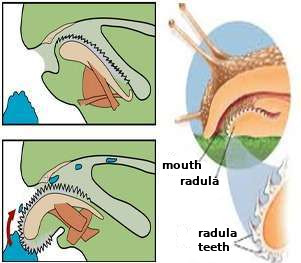
radula system
A few rare gastropods do not have a radula: the Tethydidae , the genus Clathromangelia (family Clathurellidae) and, in terrestrial environment, the species Careoradula perelegans (family Streptaxidae). Most cephalopods have a radula with the exception of the spirulae. Bivalves don't.
The radula consists of several transverse rows of teeth.
The number of rows, the shapes and the arrangement of teeth can characterize a whole superfamily (Epitonioidea : ptenoglossa radula).
The Sacoglossa order characterizes molluscs whose radula has only one row of teeth.
A row can have three types of teeth:
There are seven types of radula depending on the configuration of these three types of teeth:
docoglossa ou stereoglossa: the most primitive form, the central tooth can sometimes be absent, 3 lateral teeth (the most external dominant) and 3 marginal teeth.

rhipidoglossa: a central tooth, five lateral teeth (the most external sometimes dominant) and a large number of marginal teeth acting as a kind of broom to recover the remaining food debris.

hystrichoglossa: a central tooth , 27+14 lateral teeth and a large number of marginal teeth.

radula (left side) of Perotrochus caledonicus (1 central tooth, 22+14 lateral teeth and 53+7 marginal teeeth)
ptenoglossa: no central or lateral tooth but a large number of marginal teeth.
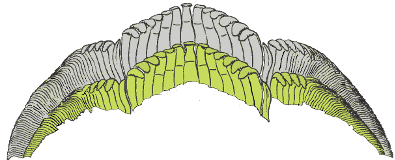
radula of Janthina janthina
taenioglossa: seven teeth in total including a central tooth, a lateral tooth and two marginal teeth (on both sides) or 2x (1 + 2) +1.

stenoglossa or rachiglossa: three teeth in total, one central tooth and two lateral teeth (sometimes only one central tooth). This type of radula makes it possible to dig powerfully into the shell of a prey and, using acid secretion, to pierce it.

toxoglossa: a very small central tooth (if not at all) and two long pointed side teeth with barbs. They contain a channel for the venom and work separately. As their connection to the base of the radula is very loose, they can be ejected like a harpoon on a prey. The radula of certain Conidae (Gastridium geographus, Cylinder textile) contains a venom that is lethal to humans.

The different types of radula show the evolution of gastropods in their mode of feeding: herbivores, detritivores, scavengers or carnivores. Scraping algae requires many teeth, according to the first three types. Carnivorous types need fewer teeth, especially lateral and marginal teeth. The ptenoglossus type is located between the two extremes and is typical of gastropods parasitic on polyps.
Carnivorous gastropods use different techniques to capture their prey:
bivalves feed on phytoplankton and microorganisms by filtering the water.
All cephalopods are carnivorous. They have a two-part beak and most have a radula, although it is small in most octopuses and completely absent in Spirula. They feed by capturing prey with their tentacles, then grab them into their mouths. They have a mixture of toxic digestive juices, some of which are made by symbiotic algae, which they eject from their salivary glands onto their captured prey. These juices separate the flesh of their prey from the shell.
mollusks follow just a few simple rules to create spiral shells. The first is expand : as the mollusk secretes successive layer of shell-building material at the shell opening or aperture, it uniformly deposits more material each time to create an even larger opening. The second rule is rotate : by depositing slightly more material on one side of the aperture, the mollusk builds a doughnut shape, or torus, from an initial circle. The third rule is twist : the mollusk rotates the points of deposition. Different combinations of these rules yield different spiral shapes. (from Scientific American)
We can note the particular application of these rules for each of the 3 classes of molluscs :
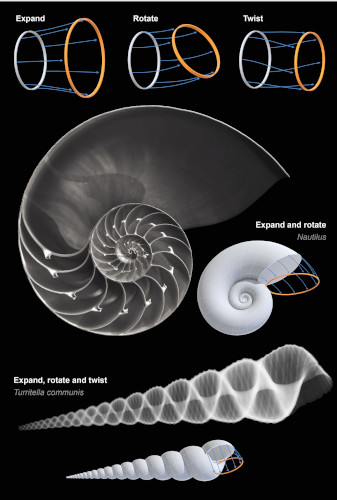
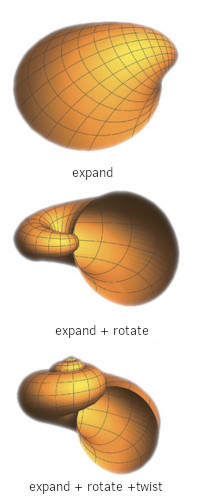
To create their shells, the seashells acquire the elements (calcium, carbon and oxygen) from their food but also from the water around them.
These elements are taken up from the blood stream by specialized cells in the mantle, they are then combined with specific proteins which produce secretion on the outer surface of the mantle.
These secretions are then deposited by the movements of the mantle on the surface of the shell, harden quickly and thus make the shell enlarge. This is called biomineralization.
The shell consists mainly of calcium carbonate (CaCO3).
The formation of the shell is more than a simple continuous addition of material to the edge of the opening. Mollusc shells are complex structures made up of three layers, each created separately.
The first two layers are made by the front edge of the mantle, at the outer lips of the shell opening.
The mother-of-pearl layer, on the other hand, is constructed by the entire surface of the mantle. Throughout the life of the animal, the mantle adds mother-of-pearl to the inner surface of the shell, making it thicker and thicker.
NB: The mantle of cowries secretes a fourth layer above the periostracum: the epiostracum which gives them this smooth and shiny appearance.
The precise description of a shell uses a very specific lexicon that it is important to know in order to fully understand the descriptive sheets for each family.
REFERENCES
french websites
english websites